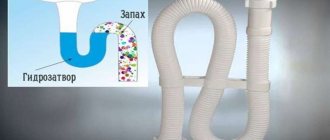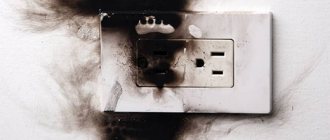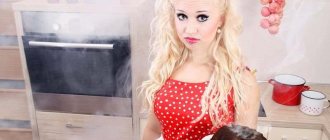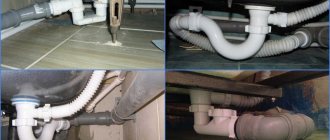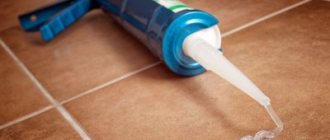How to remove odor from a sink
How to remove odor from a sink
Home smells are an important component of the idea of home and comfort. Smells shape the mood no less than the interior and color palette of the room. Delicate perfume bouquets of the bedroom and alluring aromas of the kitchen, the bright fragrance of relaxing bath foam or a thin trail of your favorite perfume - everyone has their own ideal idea of home smells. And the question immediately arises: why does the bathroom smell like sewer and an unpleasant odor from the sink, which quickly fills the whole house and literally smothers all other aromas.
You may be interested in the information - the smell from the toilet from the sewer
Why might this problem occur, and how to solve it? We'll tell you in the article.
Causes of smell in the bathroom
The most important thing is to accurately determine the source of the unpleasant odor. In the bathroom most often it is:
- clogged sewer pipes;
- problems with the siphon . To prevent odors from the sewer from penetrating into the bathroom, a siphon holds the water plug. If you smell sewage in your bathroom, then most likely there is something wrong with the siphon. It may be installed below the sewer pipe connection. Perhaps the sewer system in the house has simply not been used for a long time, the water has dried up, giving way to unpleasant odors. Another reason is improper fixation or too long use of corrugated pipes. The siphon may simply become clogged, and deposits in it begin to decompose and emit unpleasant odors. This is usually a problem in the kitchen, but it can happen in the bathroom too;
- visible and invisible leaks . Often occur at pipe junctions. At first, literally drops of water may leak out, which will be absorbed into the finishing materials, causing the appearance of mold (where there was none before) and odor;
- poor ventilation . Perhaps the general house ventilation system is clogged, or the problem is at the junction of the individual part of the ventilation with the general one. If the air from the bathroom is not properly removed, the smell will soon be very unpleasant;
- insufficient slope of sewer pipes, as a result of which wastewater stagnates;
- high pressure in the sewer caused by blockages, small diameter channels, icing. The result is that air bubbles pass through the siphon, and with them an unpleasant odor;
- dampness _ We noticed that a damp towel left in the bathroom hardly dries, and then begins to emit an unpleasant odor. Moreover, dampness and warmth are excellent conditions for the development of mold. To reduce the level of dampness in the bathroom, eliminate leaks in taps and mixers, install a border between the bathtub and the wall to prevent water from accumulating there, prevent the cistern from leaking, and dry wet towels and bathrobes on a heated towel rail or outside the bathroom;
- dirty laundry in the washing machine is the most common and easily detected source of odor.
The worst thing is the incorrect installation of sewer pipes specifically in your bathroom. Then you will need a complete replacement of the entire system. In most cases, it is possible to escape with little blood and easily get rid of the smell, however, in each specific case the principle of action will be different.
Why is sewer smell dangerous in the bathroom? A spoiled mood is the tip of the iceberg. Towels soaked in a disgusting smell are not so bad either. But inhalation of methane, hydrogen sulfide, ammonia and other compounds can provoke insomnia, anxiety, irritability and even hypoxia, bronchitis, and vapor poisoning.
Checking the serviceability of plumbing fixtures
The very first thing to do when an unpleasant odor appears from the sink or bathroom is to disassemble and clean the siphon. Very often, it is the dirt accumulated in this device, consisting of food residues or grease, that stinks. Sometimes the siphon can burst due to sudden changes in the temperature of the hot and cold water being drained. In this case, you can try to solder it using a hair dryer and a piece of plastic, or seal it with epoxy glue and fiberglass. But it is better to replace this part to be completely sure of its serviceability.
Often the cause of an unpleasant odor lies in a faulty siphon.
In addition to problems with the siphon, there are a lot of other possible reasons for the appearance of unpleasant odors in the kitchen and bathroom, namely:
- Clogged sewer;
- Leakage of water from water seals;
- Cracks in pipes or loose joints;
- Poor adjustment of sewer riser revisions.
To eliminate the causes of the malfunction, the defective location is first localized and then repaired.
Clogged drain pipes
If a blockage appears in the drain line, it must be removed. To do this, you can use a plunger after drawing a small amount of water into the sink. A vacuum cleaner can be used for the same purpose by setting its hose to blow out and then connecting it to the drain pipe. It is only necessary to first seal the connection point.
A plumbing cable can help remove severe blockages.
To remove more severe blockages, use a plumbing cable. Rotate this device and periodically turn on the water supply. This will help you deal with clogged drains faster.
In the case of plastic pipes, this method should be used very carefully
If there is no plumbing cable, then a long thin hose can correct the situation. It is inserted into the pipe, and then the entry point of the hose is blocked and water is released. Under the influence of water pressure, the blockage is gradually washed away. Additionally, it is necessary to disassemble and wash the siphon.
Lack of water in the water seal
To prevent odors from the sewer system from penetrating into the house, water seals are installed at all drain holes, which in the simplest case are a U-shaped elbow filled with water. It is the liquid that prevents the spread of stench. Water from the water seal may evaporate if the tap is rarely opened.
Also, the lack of fluid may indicate a failure of the water seal. This is what is called suction of water into the riser. This is possible in case of malfunctions in the ventilation of the sewer system, which occurs when foreign objects enter the riser, as well as when it freezes in winter. To make sure that the main sewer pipe is properly ventilated, you need to go up to the roof and inspect it.
The water seal prevents the penetration of odors from the sewer
A broken water seal is indicated by hissing or squelching sounds coming from the sink as water flows out, so to detect this malfunction, listen to the sounds coming from the drain hole.
Often a water seal is installed by installing a bend in a corrugated pipe instead of a siphon. Over time, this pipe can sag, thereby contributing to failure. To avoid this phenomenon, secure the bend with wire or insulating tape.
Elimination of pipeline defects
Cracks, crevices and leaking joints are common in older sewer systems. Various methods are used to eliminate them. Small cracks in straight sections of pipelines are repaired by applying bandages or sealing clamps. Large holes are sealed using patches and epoxy resin. Leaks in pipe connections are eliminated using tarred asbestos cord packing.
In some cases, the cause of an unpleasant odor may be depressurization of the junction of the drain and sewer pipes. It is necessary to carefully inspect the connection point and, if necessary, eliminate leaks using silicone sealant.
Removing sewer clogs
All plumbing fixtures are checked one by one with a powerful jet of water.
If somewhere the water is reluctant to drain, then we are dealing with a blockage, which can give off unpleasant odors. Although clogs are usually obvious when using your plumbing fixtures on a daily basis. deal with sewer blockages in the following ways:
- mechanical cleaning. This is a well-known plunger that will help with minor blockages and if the contamination is located close to the drain. For more complex cases, a plumbing cable , which is inserted into the pipe with rotational movements, reaching the blockage and removing it, and then rinsing everything with hot water. If the pipe has a complex shape, then it is almost impossible to cope;
- simple folk remedies for small blockages: pour half a pack of soda or salt into the drain, and after 20-30 minutes rinse it with hot water;
- half a glass of soda is poured into the drain, then a glass of vinegar is poured. The drain is covered with a cloth or stopper. After 30 minutes, the pipe is washed with boiling water;
- soda and citric acid are a famous duet that, once in the drain, begins to hiss and form foam. When the reaction stops, hot water is poured into the pipe;
- undiluted white is poured into the drain for 20 minutes, then washed with hot water;
How to eliminate sewer smell using household chemicals
In the departments of household chemicals you will find special products for removing blockages and odors from the sink in a wide variety. They help remove unpleasant odors from pipes, clear the sewer system of any organic accumulations and disinfect the internal surface.
Such products are available in 4 forms: gel, liquid, powder or granules. Be careful, most products contain toxic components, so carry out the procedure using personal protective equipment and thoroughly ventilate the room after treatment.
Popular store-bought pipe cleaners:
- Mole. The substance has long been actively used by housewives. Now the product is available in the form of a gel, liquid or powder. Dissolves hair and organic matter well. The disadvantage is usually the slow speed of impact.
- Tiret. Despite its popularity, the product is used mainly for preventive purposes. The more effective Tiret Turbo gel can only cope with minor blockages. The substance must not be used on copper and rubber parts.
- Floop. It comes in the form of granules, which begin to act in combination with hot water. A very effective product, it actively affects organic matter, so it can harm thin plastic.
- Mister Muscle. Shows its effectiveness within 2-3 hours after use. Presented in the form of granules for dilution with hot water or in gel form.
- Rowdy. An effective substance that helps remove small blockages very quickly. In more complex situations, it is enough to simply increase the exposure time of the gel.
- Pothan. Has maximum effect. Under the influence of water, the granules foam strongly, bubble and swell, which helps the substance cope with even the most complex blockages. However, an overdose of the product may cause pipe failures or mechanical damage to plastic pipes, so use Pothan strictly according to the instructions and with extreme caution.
To remove a small blockage, you can use regular white, which will also help disinfect the sewer system inside. Unfortunately, chlorine-containing substances are not able to deal with large blockages.
Normalization of ventilation
After blockages, poor ventilation is the second reason for the appearance of unpleasant odors in the bathroom. to check the presence of draft : bring the flame of a candle, lighter or match to the ventilation grille, and if it remains vertical and does not lean towards the ventilation hole, then things are bad.
Why ventilation does not work well:
- large debris entered the canal;
- the neighbors have forced ventilation;
- The bathroom has doors that do not let air flow through.
Large debris can be found by shining a flashlight into the vent. If there is something like a piece of brick lying there, then it is worth removing it. It doesn’t hurt to clean the walls of the shaft from dirt with a brush, and then remove the remaining dust with a vacuum cleaner without an attachment. After this, the grille is put back in place and the traction is checked again. Often such a simple set of measures can significantly improve the quality of ventilation in the bathroom. The door, especially in the summer, should be left ajar at least sometimes.
If everything is fine with the draft, then ventilation can be improved by installing a decorative grille at the bottom of the door, but this option is not acceptable for everyone. The most effective and at the same time the most expensive method is to install a fan in the ventilation duct to provide forced ventilation.
How does a water seal work?
Every plumbing fixture that is used in the bathroom and connected to the sewer system has a siphon. A siphon is a special device that does not allow foreign odors to penetrate from the sewer pipe into the room. It is made of brass, plastic or other material.
There are models of siphons with a water seal, a membrane seal and a dry seal. Thanks to its special curved shape with one elbow, this device creates a water plug inside that prevents air from the sewer pipe from entering the sink or bathtub. Siphons perform the following functions:
Please note that the water seal only works until the water in it dries out. Therefore, when no one uses a plumbing fixture for a long time or there is no water supply for a long time, the liquid in the siphon dries out, which is why there may be a sewer smell in the bathroom.
If the reason that the bathroom smells is because the water seal has dried out, then the easiest way to deal with this problem is to simply fill the siphon with water and thoroughly ventilate the room.
Siphon cleaning
The siphon under the sink, bathtub or shower is a good place for bacteria to grow.
Hair, particles of cosmetics, and fat settle in it, and then cool and literally stick to the walls. This is an excellent environment for the growth of bacteria, and gradually the mass of sewage only becomes larger, causing not only an unpleasant odor, but also complicating the outflow of wastewater. If the cause of the unpleasant odor lies precisely in the siphon, then the procedure will be as follows:
- remove the siphon and clean it of adhering deposits. It is appropriate to place a basin or bucket under the siphon so as not to stain anything;
- wash the siphon walls with dishwashing detergent;
- install a clean siphon in place, ensuring the tightness of all joints;
- Use drain cleaners regularly to prevent sediment from accumulating there.
The siphon (hydraulic seal) takes on an important function in terms of protection against odors. Thanks to the existence of a water plug, stench simply cannot get into the apartment. Siphons come in bottle, tubular and corrugated types. The bottle type is ideal for the sink; it is easy to install. The cheapest option is a corrugated siphon.
If there is a musty smell coming from the sink
If your sink smells musty, the siphon may be clogged or the fittings are not tightly connected and moisture is seeping into the holes, causing mold to appear.
To eliminate the smell, first check the drainage system for serviceability. If everything is fine, the next step is to unwind the siphon and check it for any accumulation of food debris. Be sure to wash the siphon components and reinstall it correctly. After installation, pour 1–2 liters of boiling water into the drain to flush the system.
If the smell of mold still remains, clean the drain with chemicals for flushing pipes or improvised substances: soda, vinegar or citric acid.
Ensuring the right amount of water in the siphon
From the above it follows that if there is not enough water in the siphon, an unpleasant aroma can spread throughout the bathroom.
It only takes a short period of time for all the water in the sink's water seal to dry out - you just don't use the sewer for a couple of weeks, and an unpleasant surprise awaits you when you return from vacation. Fortunately, this problem can be easily solved - just turn on the water, a water plug will form in the siphon again, and the smell will soon disappear. Popular wisdom suggests several ways to prevent the evaporation of water from the siphon. Before leaving, you can close the drain with a rubber stopper . Some people advise pouring sunflower oil into the drain, and upon returning, rinse the drain with an alkaline solution and plenty of hot water, but this seems too radical.
The water may not dry out completely - there just may not be enough of it. This problem is related to the shape of the siphon and is typical for S-shaped corrugated siphons. In this case, it is enough to simply install a few clamps to give the pipe the correct S-shape.
The most unpleasant option is when water from the siphon is forcibly sucked into the sewer, which is accompanied by characteristic bubbling sounds. This is usually the fault of neighbors who interfered with the sewer system of an apartment building and removed the drain pipe leading to the roof. The situation can only be corrected by reinstalling the drain pipe or choosing a high-quality aerator.
How to remove odor from a sink using mechanical methods
If the cause of the stench from the sewer is a blockage, before using odor elimination products, clean the drain using any mechanical method.
plunger
This cleaning method is the most affordable and simplest. Usually a plunger copes with the cleaning task the first or second time.
Mode of application:
- Place the plunger in the sink.
- Press the rubber pad firmly against the drain hole so that it completely covers it.
- Pour some hot water into the sink.
- Grab the handle of the plunger, alternately apply pressure and release several times in a row.
- After the last press, quickly remove the plunger from the sink.
- Repeat the procedure if necessary.
After all manipulations, rinse the drain with plenty of hot water.
Metal cable
If waste has accumulated far from the drain hole, the plunger will not have enough power to clear the pipe. In such a case, use a steel plumbing cable. The end of the tool usually has a hook or brush to help break through the clog.
Action plan:
- Remove the siphon elbow.
- Point the end of the cable into the hole and carefully push it inside the pipe.
- When you feel that the cable has collided with the plug, try to push it even deeper with pushing or rotating movements in different directions.
- Remove the cable from time to time; the hook may catch part of the blockage.
- If the cable begins to move easily, it means that the debris has been removed.
After the procedure, return the knee to its place and rinse the drain with hot water.
Country hose
The method of removing blockages using hydrodynamics, well known among plumbers, can be carried out at home without the use of expensive equipment. For the procedure you will need a regular thin hose, a nail and a soldering iron.
Scheme for manufacturing the device:
- Cut a piece of hose to the required length.
- Seal one end of it so that it does not allow liquid to pass through.
- At a distance of about 10 cm from the soldered end, use a hot nail to make several holes in a circle.
- The product is ready.
Instructions for use:
- Push the blind end of the hose into the clogged pipe.
- Attach the open end tightly to the tap.
- Turn on the water at high pressure.
- During the process, water will come out of the side holes under pressure, washing away accumulated contaminants.
- After this, remove the hose from the pipe and rinse the drain with hot water.
The procedure will help get rid of plaque and food debris.
Analysis of the plumbing unit
If there is a smell, but no blockages are found, check the pipes. Perhaps the stench from the sewer is coming to you due to contamination of the riser or plumbing unit. This is possible if the pipes are damaged or connected incorrectly. First, inspect all pipes for damage. Then disassemble the plumbing unit and reassemble it, carefully sealing the joints.
Correct installation of the bottle siphon
The design of a bottle siphon is quite simple, and installing it is not very difficult, but still a common mistake occurs when the vertical pipe is higher than the water level.
In this case, the smell from the sewer freely seeps into the bathroom. The way out of the situation is to install the siphon correctly. If you come across a design where the immersion level of the pipe can be adjusted, then solving the problem will be somewhat easier.
Why is sewer smell dangerous?
Air from the sewer, entering an apartment or house, in addition to the disgusting smell, has a negative impact on the health of the people who inhale it. It is not for nothing that a person feels an aversion to certain aromas; this happens in cases where the substances emitting these odors can cause harm.
In this case, these are substances such as hydrogen sulfide, ammonia and methane. The strongest-smelling ones are ammonia and hydrogen sulfide; methane has no odor at all, but this does not make it any less harmful. If you breathe these gases constantly, the consequences will not be long in coming. The respiratory and nervous systems are primarily affected. A feeling of anxiety, a nervous breakdown, or in rare cases, fainting may occur for no reason.
Restoring the tightness of the sewer system
Cracks, punctures, ruptures and other defects may form on the siphon, pipes, and joints that impair the tightness of the sewer system. These places allow unpleasant odors to penetrate into the bathroom, and water also leaks through them, which sooner or later will also make itself felt with a characteristic aroma. The procedure for this case is as follows:
- thorough inspection and leak detection. Run hot water down the drain and inspect the pipes with a flashlight. You can use napkins or toilet paper - they will get wet upon contact with the problem area;
- if a defect is found on a non-separable element, it needs to be replaced. Poor quality pipes are often to blame;
- if water seeps through the joint between different elements, then first you can try tightening the connection or replacing the sealing gasket. You can also try sealing the joint with FUM tape;
- As a preventative measure, make it a rule to use silicone when installing all gaskets.
Minimizing joints in pipes
Joints are not only the weakest element in terms of leaks, but also a place where dirt and plaque easily accumulate, and where the characteristic smell is not far away. Often a huge number of joints are made when connecting the bathtub to the sewer. Unfortunately, it is only possible to properly detect and remove dirt from the joints by disassembling the drain. Chemical pipe cleaners will give a temporary and not the best effect.
If possible, try to reduce the number of joints as much as possible.
Elimination of sagging drain pipe
We are talking about the bathroom. They try to position it so that the drain hole is closer to the sewer outlet. It happens that you have to position the bath differently, and a long pipe connects the drain and sewer. If it is not made of the highest quality material, then over time it may begin to sag, water stagnates in this place, and since it contains a lot of fat and skin residues, bacteria immediately settle in this environment and begin to emit unpleasant odors.
If you look under the bathtub, you can determine the sagging by eye. If there is one, then it is enough to install a support under it to ensure a slight slope towards the sewer along the entire length of the drain. The minimum slope is 3 cm per linear meter, and preferably more.
Mold control
A humid, warm environment, lots of wet towels and gowns, and problems with ventilation are ideal conditions for mold to grow.
If you have ever heard this unpleasant smell, then you understand what we are talking about. Not only does it become difficult to be in the bathroom, but also inhaling such air is very dangerous. Particularly dangerous is black mold, which can affect any surface and ultimately lead to insomnia, dermatitis, asthma, pneumonia and even lung cancer. There are many ways to combat mold:
- ready-made special products are the most reliable option. Modern fungicides do an excellent job even with black mold, but when the mold has been overcome, it is better to periodically treat it with antiseptic agents for preventive purposes. Ideally, clean off all mold-affected layers of finishing, since the mycelium takes its roots very deep;
- Bleach is a worthy replacement for special products. It is diluted with water in a ratio of 1:10, then the whole thing is applied with a brush to the affected area;
- vinegar can also be sprayed onto the affected area and washed off with a damp cloth after a while;
- peroxide is poisonous to mold, but be careful - it will discolour painted surfaces. A 3% peroxide solution is applied directly to the damaged area;
- ammonia is mixed with water in a 1:1 ratio. Works effectively on hard, non-porous surfaces. Do not mix with bleach;
- borax (1 glass) is diluted in water (2.5 l), and the solution is applied with a stiff brush;
- also use tea tree oil, lavender and rosemary oil, potassium permanganate, soda, and citric acid. The smell of mold can remain even after it is removed, and you can eliminate it with baking soda. It is left in the place where the fungus lived, and then collected with a vacuum cleaner.
Prevention of odor
In most cases, solving the problem of unpleasant odor in the bathroom is indeed not difficult, but it is even easier to never encounter such a problem, so it is still worth knowing about some preventive measures:
- simple mesh filters on the drain holes trap a huge amount of dirt, preventing rapid clogging of the sewer and the appearance of aroma;
- to clean pipes with special means once every couple of months, without waiting for a serious problem. Plaque still remains on the pipes, and it is important to “wash it off” in time, since other contaminants stick to it well;
- It is generally better to remove debris and grease from the siphon once a month;
- The draft in the ventilation duct should be checked twice a year;
- make it a rule to regularly inspect the joints of sewer pipes;
- Before leaving, cover the drain holes with a lid;
- do not forget to wash the toilet seat mounts . It is necessary to remove all elements and carefully wipe under the fasteners. These are the places where the most dirt collects. In the future, you should occasionally wipe under the seat with a brush to prevent odor;
- Use lemon cleaner to clean surfaces. It is important to buy quality substances; you should not skimp on such products;
- To fill your bath with a pleasant aroma, you can make your own air freshener . You will need a diffuser with essential oil, water and witch hazel. For a more lasting aroma, it is worth adding a few drops of peppermint oil to the solution;
- To bring a pleasant smell into the bathroom, you can make washers from essential oil and soda . Mix half a cup of baking soda and a few drops of essential oil. You should get a paste of medium thickness. Can be poured into muffin tins. We put the washers on shelves in the bathroom, a basket for dirty laundry and use them as an air freshener;
- If towels are constantly in the bathroom , wash them with the addition of vinegar. Instead of conditioner, add half a cup of purified vinegar and wash at high temperature. Then you should dry the laundry in the fresh air;
- even if the ventilation is fine, sometimes leave the door open to reduce the humidity in the bathroom.
If possible, dry towels and bathrobes on a heated towel rail or on the balcony. Do not leave dirty laundry in the washing machine or a special bucket for too long, and in general, try to clean all surfaces in the bathroom regularly. If you are too lazy to do this yourself, you can always hire a contractor to enjoy cleanliness and pleasant aromas in the bathroom.
The article was written for the site.
Tags:Bathroom, lifehack, Cleaning
Home methods
Some ordinary home remedies also work well against clogs:
- Salt and soda - a certain number of tablespoons of salt or a hot solution prepared with water and water is poured into the drain, and then it is thoroughly rinsed. Moreover, having added salt, leave it for 3 hours and then wash it. You can remove minor fatty deposits or plugs in one go. If the blockage is large, the procedure is repeated several times;
- Citric acid - it, diluted with boiling water, is slowly sent into the drain hole;
- Vinegar - adding 1 tbsp. a few tablespoons of soda, the composition is quickly poured into the hole, which is plugged with a rag;
- Dry mustard - when dry, it is poured into the sink and left for a certain time.
Drain pipes should not be dealt with when the problem has already made itself felt. This procedure should be carried out at least monthly. And if you use the home remedies above, you can clean your pipes up to twice a week. This way you will ensure relative cleanliness for them.
